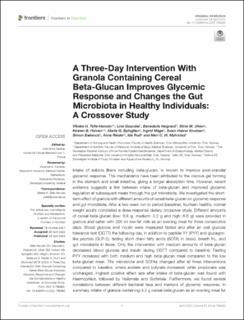| dc.contributor.author | Telle-Hansen, Vibeke | |
| dc.contributor.author | Gaundal, Line | |
| dc.contributor.author | Høgvard, Benedicte | |
| dc.contributor.author | Ulven, Stine Marie | |
| dc.contributor.author | Holven, Kirsten Bjørklund | |
| dc.contributor.author | Byfuglien, Marte Gjeitung | |
| dc.contributor.author | Måge, Ingrid | |
| dc.contributor.author | Knutsen, Svein Halvor | |
| dc.contributor.author | Ballance, Simon | |
| dc.contributor.author | Rieder, Anne | |
| dc.contributor.author | Rud, Ida | |
| dc.contributor.author | Myhrstad, Mari | |
| dc.date.accessioned | 2022-05-06T13:04:21Z | |
| dc.date.available | 2022-05-06T13:04:21Z | |
| dc.date.created | 2022-05-02T11:54:15Z | |
| dc.date.issued | 2022 | |
| dc.identifier.issn | 2296-861X | |
| dc.identifier.uri | https://hdl.handle.net/11250/2994615 | |
| dc.description.abstract | Intake of soluble fibers including beta-glucan, is known to improve post-prandial glycemic response. The mechanisms have been attributed to the viscous gel forming in the stomach and small intestine, giving a longer absorption time. However, recent evidence suggests a link between intake of beta-glucan and improved glycemic regulation at subsequent meals through the gut microbiota. We investigated the short-term effect of granola with different amounts of cereal beta-glucan on glycemic response and gut microbiota. After a two-week run-in period (baseline), fourteen healthy, normal weight adults completed a dose-response dietary crossover study. Different amounts of cereal beta-glucan (low: 0.8 g, medium: 3.2 g and high: 6.6 g) were provided in granola and eaten with 200 ml low-fat milk as an evening meal for three consecutive days. Blood glucose and insulin were measured fasted and after an oral glucose tolerance test (OGTT) the following day, in addition to peptide YY (PYY) and glucagon-like peptide (GLP-2), fasting short chain fatty acids (SCFA) in blood, breath H2, and gut microbiota in feces. Only the intervention with medium amounts of beta-glucan decreased blood glucose and insulin during OGTT compared to baseline. Fasting PYY increased with both medium and high beta-glucan meal compared to the low beta-glucan meal. The microbiota and SCFAs changed after all three interventions compared to baseline, where acetate and butyrate increased, while propionate was unchanged. Highest positive effect size after intake of beta-glucan was found with Haemophilus, followed by Veillonella and Sutterella. Furthermore, we found several correlations between different bacterial taxa and markers of glycemic response. In summary, intake of granola containing 3.2 g cereal beta-glucan as an evening meal for three consecutive days reduced the glycemic response after an OGTT 0-180 min and changed gut microbiota composition. Since we cannot rule out that other fiber types have contributed to the effect, more studies are needed to further explore the effect of cereal beta-glucan on glycemic regulation. | |
| dc.description.abstract | A Three-Day Intervention With Granola Containing Cereal Beta-Glucan Improves Glycemic Response and Changes the Gut Microbiota in Healthy Individuals: A Crossover Study | |
| dc.language.iso | eng | |
| dc.title | A Three-Day Intervention With Granola Containing Cereal Beta-Glucan Improves Glycemic Response and Changes the Gut Microbiota in Healthy Individuals: A Crossover Study | |
| dc.title.alternative | A Three-Day Intervention With Granola Containing Cereal Beta-Glucan Improves Glycemic Response and Changes the Gut Microbiota in Healthy Individuals: A Crossover Study | |
| dc.type | Peer reviewed | |
| dc.type | Journal article | |
| dc.description.version | publishedVersion | |
| dc.source.volume | 9 | |
| dc.source.journal | Frontiers in Nutrition | |
| dc.identifier.doi | 10.3389/fnut.2022.796362 | |
| dc.identifier.cristin | 2020578 | |
| dc.relation.project | Norges forskningsråd: 314599 | |
| dc.relation.project | Norges forskningsråd: 314111 | |
| dc.relation.project | Norges forskningsråd: 314318 | |
| dc.relation.project | Nofima AS: 202101 | |
| dc.relation.project | Nofima AS: 202102 | |
| dc.relation.project | Nofima AS: 202103 | |
| cristin.ispublished | true | |
| cristin.fulltext | original | |
| cristin.qualitycode | 1 | |
